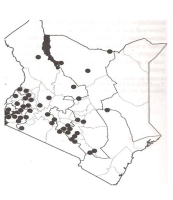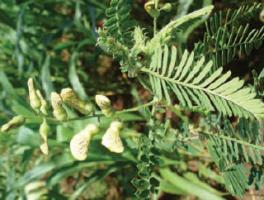Geographical Distribution of Sesbania sesban in Africa (red marked), source ICRAF. Updated on 27th March 2019.
Introduction
Geographical distribution
 |
| Distribution of Sesbania sesban in Kenya |
| © Maundu P. and Bo Tengnas. (2005). Useful trees and shrubs for Kenya, World Agroforestry Centre. |
General Information about the Tree:
Biophysical Limits:
Description
Bark: Red-brown, young shoots hairy.
Fruit: Abundant bunches of think pale brown pods to 20 cm, with separated sections so seeds rattle within.
Propagation and Tree Management
Uses:
Firewood, poles, medicine (ground leaves), fodder (leaves), shade (young coffee), mulch, nitrogen fixation, soil improvement, soil conservation, fibres (young stems), soap (leaves).
Propagation and Tree Management:
 |
| Sesbania sesban fruits |
| © Patrick Maundu, World Agroforestry Centre |
Products:
- Food: Flowers of this tree are edible and are included perhaps as a decorative or festive ingredient in foods such as the omelettes.
- Fodder: It has a high percentage of foliage nitrogen and is an excellent supplement to protein-poor roughage in ruminant diets. The ruminants readily eat leaves and young branches
- Fuel: This tree is popular for firewood and charcoal because it has a high woody biomass, which, although soft, is relatively smokeless, quick kindling and hot burning.
- Fibre: it is used for making ropes and fishnet and has potential for pulpwood production.
- Soap: its leaves can be used in soap making.
- Gum or resin: Seeds and bark produce gum which can be economically exploited.
- Poison: Saponin, stigmasta-galactopyranoside, which can be isolated from the seeds, has glucuronide derivatives of oleanolic acid, which has molluscicidal activity against Biophalaria glabrata, one of the known snail vectors of schistosomiasis.
- Medicine: Fresh roots and leaves are used to treat scorpion stings, boils and abscesses. The decoctions of leaves can be used as a drench for cattle to repel tsetse fly. It is also used to treat sore throat, gonorrhoea, syphilis, spasmodic fits in children and jaundice during pregnancy among some communities. The leaves can also be used in some countries as a tea and are considered to have antibiotic, antihelmintic, antitumour and contraceptive properties. Oil from the seeds is accorded special properties too.
Services:
- Shade or shelter: It has been used to shade coffee, tea and cocoa. It has also been used as a windbreak for bananas, citrus and coffee preventing them from destruction.
- Soil fertility: It can increase soil nitrogen through symbiotic interaction with bacteria; has the ability to stabilize soil, and in some parts it has been used as green manure for rice. The branches have been used as mulch and leaves as a green manure.
- Intercropping: It is a promising shrub for alley cropping because is established easily, it grows rapidly, coppices readily and provides mulch of high nutrient content. In some climates, such as in the Kenyan highlands, it may have a sparse canopy, and weed competition can be a problem. This characteristic makes it a good intercrop.
- Shade: the tree provides shade to both livestock and humans in hot weather.
- Boundary or barrier or support: It can be suitable for use as live trellises for pepper.
Seed:
The species is a prolific seeder with a high germination rate. About 110'000 seed per kg. Germination about 80%.
Treatment:
Not necessary for fresh seed, soak stored seed in cold or tepid water for 24 hours before sowing.
Storage:
Seed can be stored for long periods if kept in a cool and dry place, but best germination from fresh seed.
The species may harbour root-knot nematodes. The genetic diversity of Sesbania types allows for selection (e.g. for different uses, management, soil types). The leaf mulch and nitrogen-fixation features make this a tree of great potential for intercropping and thereby soil improvement on small farms.
Pests and Diseases
Information Source Links
- Bekele-Tesemma, B. (2007). Useful trees and shrubs for Ethiopia. World Agroforestry Centre, Nairobi, Kenya. ISBN 92-9059-2125
www.worldagroforestry.org - ICRAF, Sesbania sesban www.worldagroforestry.org
- Maundu, P. and Tengnäs, B. (2005). Useful trees and shrubs for Kenya. World Agroforestry Centre. ISBN: 9966-896-70-8
www.worldagroforestry.org - Heering, J.H. and Gutteridge, R.C. (1992) Sesbania sesban (L.) Merrill. In:'t Mannetje, L. and Jones, R.M. (eds) Plant Resources of South-East Asia No. 4. Forages. pp. 198-200. (Pudoc Scientific Publishers, Wageningen, the Netherlands
- www.worldagroforestry.org
